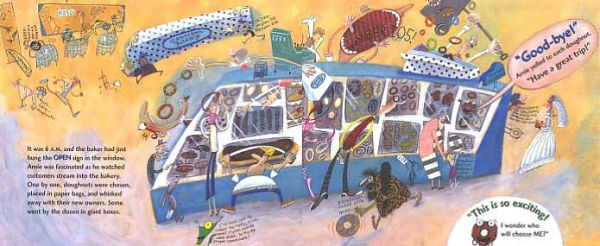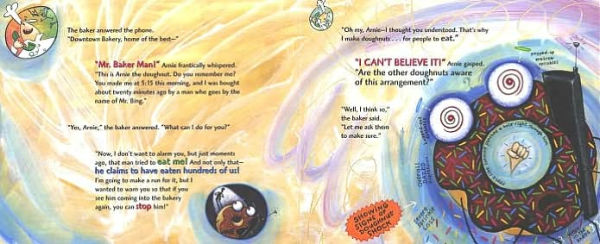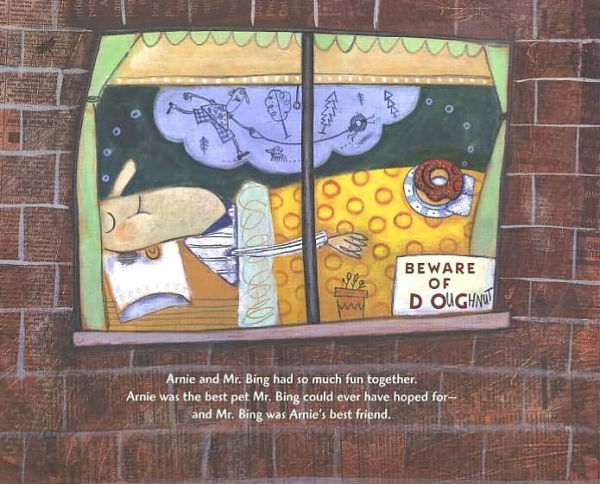Arnie takes destiny into his own hands with vastly entertaining results.” —Publishers Weekly, starred
“Laurie Keller is a goofball. She's a genius. She's a goofball and a genius.” —New York Times Book Review
“Keller gives 'pet food' a new meaning in this savory outing. . . . so deliciously silly is this confection, that few readers will pass up second helpings.” —Kirkus Reviews
“[G]ood for a belly laugh.” —Newsday
“Arnie is one of the cleverest and funniest books I've seen in a long time.” —BookPage
“[P]acked with fun and sprinkled with so many illustrative and humorous asides.” —Star Tribune, Minneapolis, MN
“In picture books, usually only dogs are as funny as this. Keller doesn't miss a trick.” —San Diego Union Tribune
“Keller's riotous collages. . . .which are filled with gleeful puns, winning characters, and over-the-top silliness, are as manic and fun as a sugar high.” —Booklist
“Off-the-wall humor and zany artwork” —Seattle Post Intelligencer
The Barnes & Noble Review
A death-defying doughnut becomes a pastry pet in this laugh-out-loud picture book from Laurie Keller, author of The Scrambled States of America.
From the doughnut case in the bakery where he’s been freshly made, Arnie spends time chatting with cruller chums and fraternizing with fellow fritters. But as his pals get sold off one by one, Arnie longs for a new friend. He’s delighted to be picked out by Mr. Bing, who takes him home to become a tasty treat. Arnie, who never realized he was meant to be eaten, has a talk with Mr. Bing -- who soon realizes he “wouldn't feel right” about eating the little pastry. They brainstorm about what Mr. Bing can do with Arnie; and after rejecting several ideas (like making him Mr. Bing’s personal fitness trainer or the air freshener in his car!), they decide Arnie is best suited to being a loyal “doughnut dog.”
A truly original tale that showcases Keller’s eye-catching artwork (think Simms Taback meets Tedd Arnold), Arnie, the Doughnut is food for fun. Readers will gobble up the little witticisms and busy extras that Keller has added, and they'll cheer over Arnie's doggie destiny. Arnie scores a hole in one! Matt Warner
Arnie, a chocolate-frosted with sprinkles, "knew that people all over town made special trips... to buy doughnuts of their very own." He reminisces fondly on the frying and cooling process that brought him into the world, and casually flirts with the apple fritter on the tray beside him. His na ve excitement suggests he does not realize his fate, confirmed by his comments after his purchase by Mr. Bing (" `Why does he keep me in this bag?' Arnie wondered"). When Mr. Bing tries to eat his breakfast, the title character reacts in disbelief. Arnie, after a near escape, borrows a phone to "warn the others," and learns that his fellow doughnuts sacrifice themselves freely: "Yes, we know! We're delicious!" they shout. Failing to foment rebellion, Arnie, along with Mr. Bing, must decide what a doughnut is good for, other than eating (" `I need a new bowling ball.' `Well, don't look at me!' " Arnie retorts). As in her The Scrambled States of America, Keller packs the spreads with comical stage business and extemporaneous asides. Roly-poly doughnut holes make fun of a jelly-filled ("Eeeooo! His brains are oozing out!"), a bear claw growls, and a beret-wearing cruller teaches Arnie to speak French. The hero himself, with spindly arms and legs and a hole where his nose would be, clowns around in the margins. Like Chris Raschka's Arlene the Sardine, this witty book calls attention to the foods people take for granted; unlike vacuum-packed Arlene, Arnie takes destiny into his own hands, with vastly entertaining results. Ages 4-8. (Apr.) Copyright 2003 Reed Business Information.
Wacky writer-illustrator Laurie Keller's latest book is Arnie the Doughnut. This is the kind of title that makes reviewers cringe. Will it be yet another terrible children's book dominated by an anthropomorphic character that stands for a value the author wants to teach? This book is nothing but fun! Goofy caricatures and bright colors beckon from the cover, which tells us the book has been "cooked up by" Laurie Keller. Her stick-legged doughnuts start cracking on their author right away. "I'm sorry, but that girl can NOT cook!" comments one. "I know, I know-it's a figure of speech," explains another. These side comments set the tone and appear throughout the book, adding humor, word play and inviting children to wonder. Arnie is Everydoughnut, an existential pastry looking for truth and his place in the world. Arnie is a well-rounded character in more than physical appearance. We meet him fresh out of the fryer, newly iced, sprinkled, and named and already flirting with an unresponsive Apple Fritter who does not want to count his sprinkles. Right away Arnie shows his enthusiastic and positive nature, assuming "she's not a morning doughnut." Arnie waves goodbye to each and every doughnut purchased until he's bought by Mr. Bing and cushioned on the bumpy ride home by the soft napkin "the baker had so thoughtfully placed underneath him in the bag." Then Arnie is startled by a chain of events. Our hero learns that Mr. Bing intends to eat him, has eaten hundreds of doughnuts before, and most shocking of all, others of his kind are "aware of this arrangement." Arnie goes into "doughnut shock suffering severe sprinkle loss." But who can eat a doughnut with that much personality? Arnie's won theheart of Mr. Bing and his readers. Keller offers giant helpings of riotous one-liners, a voice that is sweetly upbeat and bitterly ironic, a delicious story romp, an luscious hero, and many opportunities for children to look beneath the sprinkles of a doughnut and imagine the world from Arnie's point of view. No obvious lessons here, they have all been baked into the story batter! 2003, Holt,
— Susie Wilde
K-Gr 3-Similar in style and format to Keller's Open Wide (Holt, 2000), this fun-filled adventure takes readers to a bakery. A chocolate-covered doughnut serves as guide, describing each of the steps involved in the creation of various confections. Poor Arnie, however, is clueless as to why people buy tasty treats, and when he is sold to Mr. Bing, he is shocked to discover his fate. Refusing to be eaten, he devises numerous reasons why he should remain whole and ways that he might benefit his new owner. The story becomes quite silly, as both characters think of ridiculous alternatives to the traditional role of a doughnut. Arnie suggests, "I could be your chauffeur," and Mr. Bing replies, "But you can't see over the steering wheel." Then Arnie volunteers to be a bodyguard, and Mr. Bing quips, "Who could you protect me from-a cookie?" In the end, the pastry is substituted for a pet and becomes a "doughnut-dog," doing tricks, attending obedience school, protecting Mr. Bing's abode, and becoming his best friend. Done in acrylic paints and collage, the cartoon artwork flows all over the pages, showing a multitude of details and amusingly bizarre drawings. Filled with offbeat humor, this fantasy spoof also highlights Arnie's optimistic, can-do personality. Kids will eat it up.-Rita Soltan, formerly at Baldwin Public Library, Birmingham, MI Copyright 2003 Reed Business Information.
Keller (Toys!, 2000, etc.) gives "pet food" a new meaning in this savory outing. Proud of his sprinkles and chocolate icing, Arnie the doughnut takes his place at the bakery counter, and watches his tray mates depart with customers until it's finally his turn. His excitement at being taken out into the wide world in a paper bag changes to horror when he discovers that he's about to be eaten; fortunately, he is spared that fate, as the gent who bought him suddenly has no appetite for a talking doughnut. But if Arnie's not to be breakfast, then what? After rejecting several career alternatives (" 'You'd make a fine paperweight.' 'BORING.' 'How about an air freshener for my car?' 'How about not?' "), Arnie settles at last on becoming a doughnut-dog, and rolls on to a happily-ever-after as Man's Best Friend. Strewn with text lines, onlooking pastries, snappy side comments, unusual road signs, and other details, the frenetic postmodern illustrations may require more than one run-through to absorb-but so deliciously silly is this confection, that few readers will pass up second helpings. A tasty chaser for Toby Speed's Brave Potatoes (2000) or any version of the Gingerbread Man.










